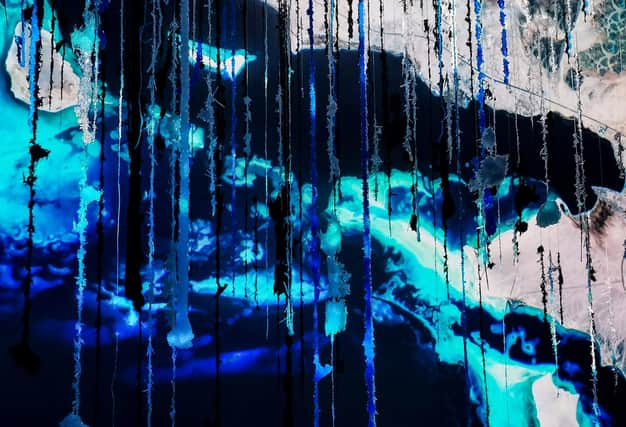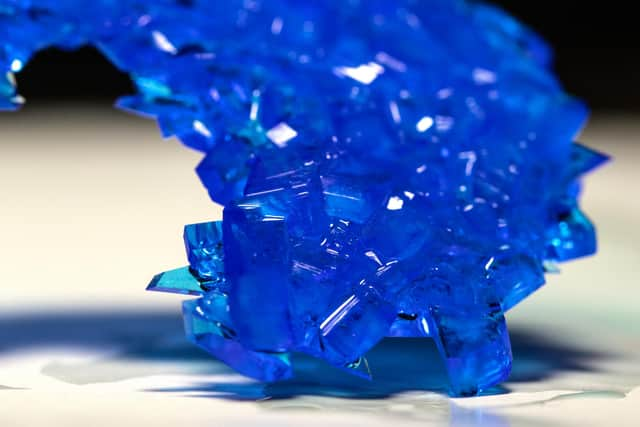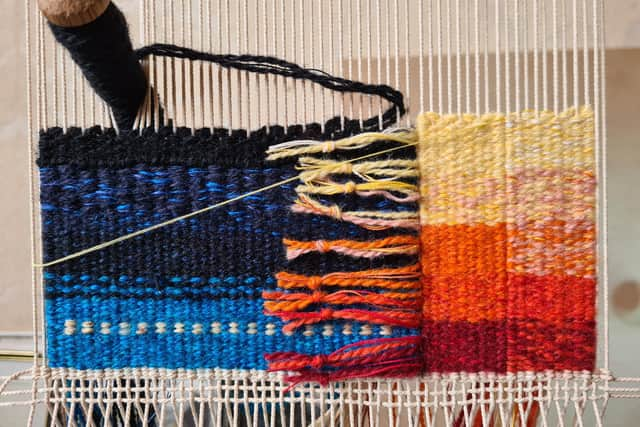Where art and science collide: The Space and Satellites Artist Residency exhibition at Edinburgh's Inspace


On a normal day, a constant stream of traffic thunders along St John’s Road in Edinburgh’s Corstorphine. But, as lockdown brought an end to “normal”, the city’s major arteries fell silent. Surely, we all thought, the air must be less polluted than before?
Roy Thompson, a retired professor from Edinburgh University’s School of Geosciences, was collecting the proof by taking readings of nitrogen oxide levels at his kerbside monitoring station on St John’s Road. Translated into a coloured chart as part of a collaboration with a textile artist and curator, his data is unmistakable: red rush hours in January and February give way in April to clear, unpolluted blue.
Advertisement
Hide AdThis is one of five art-science collaborations being showcased in an online exhibition by Inspace, the project space of Design Informatics which is part of the Bayes Centre, Edinburgh University’s hub for data science and artificial intelligence. Along with a tapestry design about air quality during lockdown, there is a story-zine exploring how satellites monitor forests, a sound work imagining how satellites communicate, salt crystals glimmering with the flight patterns of puffins and a dancer creating the shapes of sulphur dioxide molecules on a northerly beach.


The short residency on the theme of Space and Satellites Data was intended to relaunch the gallery in the Bayes Centre on Potterrow as a public space for art-science collaboration, but the work is now being showcased online, with the hope of a physical exhibition later.
Jane Macdonald, manager of Inspace and producer on the project says: “It’s about opening things up. Often some of the science and data looks quite hard to understand and interpret, you don’t often see how it impacts you. Artists manage to bring these things to life, help people see them differently. The scientists have been keen to get involved, for them it’s interesting to see how their data is being used in ways they hadn’t thought of before.”
Dr Murray Collins, Chancellor’s Fellow in Space and Satellite Analysis in the School of Geosciences, and one of the names behind the Scotland’s Secret Space Race podcast, says the project will help raise awareness of what Scotland is already achieving in the field of Space and Satellite Data. “People will learn that Edinburgh is a space university and Scotland has a burgeoning space industry,” he says. “There is a massive awareness-raising component in this for people who might not engage with satellite science but might engage with an artist’s interpretation. I hope that the younger generation might look at this and choose to engage with science and technology as a career.
“A lot of things we take for granted now are delivered by satellite technology, like having a sat-nav or Google Earth on your mobile phone. This exhibition shows the range of things satellite technology does, whether looking out into space or observing things on the earth. For that to be represented in these fascinating ways is really exciting.”


Both artists and scientists talked about the opportunities the project provided for understanding their different worlds. Artists learned about selecting and representing data while retaining the integrity of the science. Scientists learned that artistic processes might not be so different from their own. Edinburgh-based company Ray Interactive provided invaluable support in terms of data visualisation.
Advertisement
Hide AdFor design curator Stacey Hunter, who worked on the project with weaver Ben Hymers from Dovecot Studios, the residency was a chance to take on a lockdown challenge. “A lot of my projects had been put on hold. I didn’t know anything about data but it fascinated me, and I had never collaborated with a weaver, so this was a good time to try something totally different.
“If felt like we were at the beginning of this natural forced experiment. Instead of hypothesising what could happen if we all stopped driving about and burning fossil fuels, it was going to happen and we would to find out. I thought tapestry would be a really beautiful way of tracking these changes.”
Advertisement
Hide AdInspired by the Powers of 10 short films by the American designers Charles and Ray Eames, Hymers and Hunter created Everyone, a tapestry design using three data perspectives: Roy Thompson’s close-up data on air pollution, a regional model showing the hot spots for nitrogen oxide emissions across central Scotland created by another scientist, Massimo Vieno, and a satellite picture turned into a repeating pattern for the border.
Hunter says: “Designers are very good at problem-solving, being able to see the big picture, and at communicating and networking with lots of different people - they have to be. One thing they can do is take really complex information and tease out messages from it. They can pull out things that a scientist might not be aware of, something that might be intriguing or magical to someone who hasn’t seen it before.
“Ben and I have really enjoyed working on this. It went from being a collaboration between us to being a group design project with everybody on the team. Edinburgh is the most congested city in the country, car traffic pollution is a really big issue. If there could be more projects like ours, it could raise awareness with more specificity about where the pollution is coming from.”
Meanwhile, artist Elaine Ford was experimenting with growing salt crystals in her kitchen. Edinburgh-based Ford has BSc in Biology with Ecology and an integrating MSc in Tropical Biodiversity as well as a Fine Art degree, and has a particular interest in the movement of animals.
She was able to access satellite data collected by the RSPB from tracking devices on puffins in four bird colonies in Shetland and the Shiants. Datapoints plotted the daily journeys taken by the birds in search of food, which she then matched with bathymetric data about the depth and temperature of the oceans.
She says: “Puffins are amazing. They are able to navigate vast distances, explore the oceans for years and then come back to the exact nesting site where they were born, it’s still a mystery how they do it. They are also a red-listed endangered species, with climate change a major factor. Puffins are an indicator of ocean health.”
Advertisement
Hide AdThinking about the fragility of the environment, she hit on the idea of working with a material drawn from the ocean - salt. A section of the kitchen in her flat was set aside for growing crystals, with the project then moving to the lounge where there was space for a larger installation. In Saltworks, she attached wires to the datapoints for the journey of a single puffin, with the lengths mirroring the ocean depth, then grew salt crystals on the wires and lit them by projecting a film of puffin data. The result is beautiful, mysterious, and anchored in specific science.
She says: “I hadn’t used satellite technology in art before, so this was a good opportunity to explore that. The residency highlighted the power of combining art, science and technology to see the data and the world in a different way. It shows how much art and science can connect when they’re often thought to be very separate. Really, they are both are human attempts to understand the world.”
Advertisement
Hide AdThe Space and Satellite Artist Residency exhibition is now on show at https://inspace.ed.ac.uk
A message from the Editor
Thank you for reading this story on our website. While I have your attention, I also have an important request to make of you.
With the coronavirus lockdown having a major impact on many of our advertisers - and consequently the revenue we receive - we are more reliant than ever on you taking out a digital subscription.
Subscribe to scotsman.com and enjoy unlimited access to Scottish news and information online and on our app. With a digital subscription, you can read more than 5 articles, see fewer ads, enjoy faster load times, and get access to exclusive newsletters and content. Visit https://www.scotsman.com/subscriptions now to sign up.
Joy Yates
Editorial Director